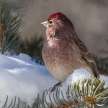
The variegated tinamou (Crypturellus variegatus) is a tinamou type typically found in humid lowland forests in northern subtropical and tropical regions of South America. Crypturellus consists of three words, in Latin or Greek: kruptos, meaning "shield" or "cover," oura, meaning "head," and ellus, meaning "diminutive" Thus, Crypturellus means "tiny veiled tail." Both tinamou belong to the family Tinamidae and even ratites are in the broader scheme. Tinamous, like other ratites, can float but in general they are not fast fliers. The ratites are ancestral to extinct flying birds and tinamous are the nearest surviving relatives to such species. The variegated tinamou was first described by Johann Friedrich Gmelin in 1789 from a specimen from Cayenne, French Guiana. The variegated tinamou is between 29.5-33 cm tall. The top back is rufous, with lower back and black wings with eye-catching yellowish edges. The throat is brown, with a light rufous neck and upper breast and a lower breast and a black belly. The flanks are also tinged with cinnamon and dusky white barring. The sides of the crown and head are black with a yellow bill, and the legs are greenish to yellowish brown. Unlike other tinamous, or low-lying trees, the variegated eats fruit from the ground. They also consume small numbers of invertebrates, seeds, tender herbs, berries, and roots. The male incubates the eggs which can come from as many as four different females, and then holds them up until they can be autonomous, usually 2–3 weeks. The nest is on the ground in dense scrub, between elevated root buttresses. We have a call consisting of five tremulous, regularly pitched notes, often merging the notes into a trill, but the first note is often distinct and it's down. The variegated timamou lives in dense lowland tropical undergrowth forests in southern and eastern Colombia, southern Venezuela, French Guyana, Suriname, Guyana, Amazonian Brazil, eastern Peru, eastern Ecuador and northern Bolivia. We are aiming for an altitude of between 100 and 1,300 metres. The IUCN ranks this tinamou as Least Concern, with an occurrence range of 5.400,000 km2. While its numbers are significantly diminished in at least parts of its range, Variegated Tinamou is still widespread, from southeastern Brazil to Amazonia, from north to Guyana and southern Venezuela, and from east to peru. This occurs in a variety of habitat forms and occurs at least 1300 m downstream. Variegated Tinamou, a middle-sized member of his genus, has heavily barred black and rusty upper parts, and a bright neck and breast flavoured with cinnamon. The species ' breeding behaviour has been studied comparatively well, but the majority of our knowledge is based on a study carried out as long ago as the 1920's. Males continue to greatly outnumber females, resulting in the female being serially polyandrous, marrying up to four males, laying one egg per mate, and incubated by the male alone. The nest, as is characteristic of tinamous, is a low, unlined depression on the ground. The single young individual leaves the nest at hatching and is tended by the male throughout. The Variegated Tinamou has a greyheaded whitish throat. The collar and underparts are reddish brown, with the rest of the barring body being dusky and black. It is similar to the Bartlett's Tinamou but differentiated by having a dusky head and preferring the Terra Firme Grain. The Variegated Tinamou is fairly common and mainly restricted to the Terra Firme forest. In the eastern foothills of the Andes it is recorded to reach to 1000 m elevations. Despite the fact that the demographic trend continues to deterioration, the deterioration is not regarded as rapid enough to hit the Poor thresholds under the criterion of demographic model
About the Creator
MB
I am a bird aficionado and really enjoy spotting them them on hikes. I greatly appreciate the variety of birds cross North America and the world. They are amazing and intelligent creatures, each so unique and with a wonderful life.






Comments
There are no comments for this story
Be the first to respond and start the conversation.